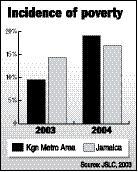
Poverty in the Kingston Metropolitan (KMA) jumped 50 per cent in 2004 even as the number of poor people across Jamaica dropped that year by two percentage points to 16.9 per cent, reflecting an overall 11.5 per cent decline in poverty levels, according to a new report on the quality of life in the island.
The annual survey of living conditions, produced by the Planning Institute of Jamaica (PIOJ) and Statistical Institute (Statin), uses consumption patterns, rather than declared income, to measure poverty here.
In 2004 it set the adult equivalent poverty line, in current Jamaican dollars, at $58,508.50.
Poverty line
However, for a reference family of five, including two adults and three children, the poverty line was 221,130.78.
According to the PIOJ/Statin document, mean per capita consumption in 2004 reached $102,302, an increase of 16.2 per cent over the previous year.
But with average inflation of 13.6 per cent in 2004, this translated to constant 1990 dollars of J$8,882, an increase in real consumption of 1.4 per cent and a 2.2 percentage points decline in the incidence of poverty - from 19.1 per cent in 2003 to the 16.9 per cent in 2004.
But while overall poverty declined, the number of poor people in the KMA increased for the first time in a decade, rocketing from 9.5 per cent to 14 per cent.
"This is the first time since the start of the (survey in 1987) that the incidence of poverty has been greater in the KMA than in any other region," the document said.
There were noticeable fall-offs in spend on education, housing and household durables, and transportation, some of which was offset in higher consumption in the health care, recreation and clothing/footwear categories.
"Prior to 2004, the KMA had consistently recorded the lowest incidence of poverty in Jamaica, followed by Other Towns and then Rural Areas," the report said.
Incidence of poverty
In fact, in 2004, the incidence of poverty in the KMA was nearly double 7.8 per cent in Other Towns, which, for these urban centres, was a sharp decline from the previous year's 15.8 per cent.
In rural areas, during the review period, poverty declined marginally, to 22.1 per cent, from 24.2 per cent in 2003.
But even as the proportion of poor people in the capital increased, the citizens of the KMA consumed more than people living in other region. For instance, mean capita consumption in the capital, at current prices, was $131,959, $16,113 or 14 per cent higher than people in other towns. Compared to rural residents per capita consumption in the KMA was $53,675 or nearly 69 per cent higher.
The document provided no explanation why poverty hiked so sharply in the KMA - the major commercial centre, where nearly half the country's population lives - in 2004 and whether the trend was likely to have been reserved in the short-term.
According to the survey, the poorest five per cent of Jamaica accounted for 6.6 per cent of consumption, while the wealthiest five per cent were responsible for 46 per cent.
However, female-headed households in 2004 increased their mean per capita consumption by 22.8 per cent, nearly twice 12.4 per cent, the level of increase in male-headed households. However, the $95,281, at current prices, female-headed households consumed, was $14,638 or 15 per cent below those of homes where males were at the helm.

